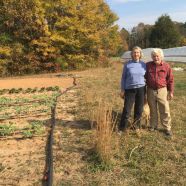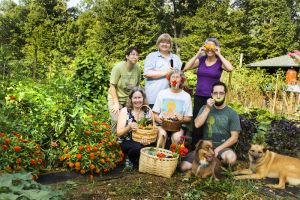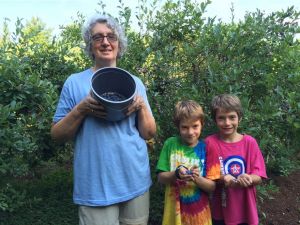Sharing the Land
When I was growing up in New Jersey my agronomist father kept a vegetable garden and some fruit trees. In the summer my favorite assigned task was to pick either strawberries or raspberries for dessert, depending on the season. I can still see the metal bowl I used to fill to the brim and I can still taste the fresh berries I savored while sitting out on the screened front porch of our yellow brick house in the shade of a very tall, very large pine tree.
No wonder then that as an adult, as soon as I had land of my own I was motivated to grow my own garden.
The “Farmette”
When my husband Vann and I decided to buy a mostly wooded forty-acre parcel of land and build a house out in the country, I persuaded him to choose the lot with a level, south-facing area so I could grow a sizable vegetable garden. We started with a small plot and when my husband saw that I wanted to plant more vegetables, he enlarged the area.
Now, the challenge I faced was summer vacation. I have the dearly held habit of going to France to connect with relatives and friends and my French heritage. What to do about weeding and picking ripe vegetables when you are absent for three weeks? One year a neighbor offered to have her young teenage son weed and water. I came back to find my favorite tool broken and some of the vegetables weeded out but the weeds thriving. Then I had the idea of asking friends to pick vegetables and to water but was reluctant to ask them to weed. At least that way few vegetables were wasted. But it was cumbersome to draw up a calendar of which friend was available to come what day of the week.
One of my friends suggested that I ask people to fully participate in the gardening from planting to harvesting to cleaning up. She did not have a sunny area around her own home and would enjoy having some gardening space. I soon ended up with six families participating in the gardening project; some were friends of my daughter. Early spring we would meet at my house and decide what we wanted to grow and how we would lay out the garden. We had a calendar with work days designated for each person according to their availability. Each person picked produce on their work days and thus all had access to their fair share. The schedule usually had us working in pairs. I varied my own schedule and would work with almost everyone at some point during the growing season.
We grew produce I had not grown before, some unfamiliar to me such as burdock, holy basil, and fennel. We decided to intersperse edible flowers and flowers for dining room bouquets among the vegetables. One friend said the flowers were what she cared about most. In the late summer we had a group dinner where everyone made a dish using our garden produce. In 2014 we were featured in Chapel Hill Magazine.
I love being able to provide gardening space for friends who do not have access to sun, space, or adequate soil. An unexpected benefit of our land use sharing is the sense of camaraderie. We share our excitement about a crop with bountiful yield and discuss ideas about how to improve our gardening methods based on our book research or talking to farmers or other gardeners. We sometimes talk about our personal concerns or joys while weeding. We have learned that with the wide variety of crops we always have some that do well to compensate for those damaged by weather or pests.
Sharing the farmette is not just about our sharing a large and sunny open space with a deer-proof fence. It is about sharing, doing, and learning together. I have to admit it also allows me to go on vacation without worries. Our farmette also provides the medium for chicken manure. My husband, Vann, loves to raise chickens although he does not eat eggs. We feed the chickens with our scraps and the manure fertilizes the garden. Our friends benefit by receiving free-range eggs.
In retrospect, our farmette was just the first step in how my husband and I now share land resources. Not only was my dad an agronomist but he and my mother greatly valued land and bought several hundred acres in Pennsylvania when I was in my teens. Initially I thought of Green Acres, the name given the land by my parents, as a country retreat with wild blueberry, blackberry, and raspberry bushes. I became attached to the land and became familiar with its streams, fields, and forest. The family tradition of the yearly visit to Green Acres, with berry picking and blueberry pancakes, with just enough dough to hold together the blueberries, was introduced to my children at a young age. Now we continue the tradition with our grandchildren.
The Blueberry Farm
But this is not the end of our land-sharing story for us. A while back as we were driving somewhere, I vividly recall my husband asking me: “What would you do if we had extra money?” My almost automatic answer was: “I want to buy land to help some young aspiring farmers who cannot afford to buy their own land.” The final ingredient for the recipe of my agricultural life was finally added to the pot that already included parents who imparted a love of land and agriculture; marriage to a husband with similar values; thriftiness; and experience. As a county commissioner, I had learned that Orange County has good agricultural acreage, that young farmers face the challenge of unaffordable property prices even for farmland, and that the local agricultural economy is treasured by the community.
Vann did the initial investigation of properties for sale. My only stipulation was that it had to be in Orange County. He reported that many properties had no roads, wells, or houses. Finally, he announced finding an interesting property with all the necessary infrastructure and sufficient cleared land for farming. My daughter and I accompanied him to check it out.
We drove up to Cedar Grove and when he turned into the driveway off Highway 86, my daughter and I exclaimed “this is where we pick blueberries!” (Cedar Grove Blueberry Farm). Even before seeing the remainder of the ninety-two-acre property, I fell in love with it, as blueberry picking was a long-standing family tradition. Vann was excited because there were several ponds with the three-acre pond being of the most interest. He had been hankering for a pond ever since I met him. The land had not been farmed in decades except for the preexisting three acres of thirty-year-old blueberry bushes. It was just what we wanted. Not only would we help some yet-to-be-identified farmers but we would be putting agricultural land back in production.
My father, a retired agronomist, came down and with a spade he dug up some soil from several abandoned fields, crumbled it in his hands, and assessed the quality of the soil. It passed his agronomic standards. He pestered us starting the day he went home, asking when we were going to purchase it. I kept telling him that you don’t buy land in a day. We made our initial offer just before leaving for our yearly trip to visit relatives and friends in France. We negotiated back and forth while there and reached an agreed-upon price.
Back stateside we now realized that before we could find farmers, the buildings needed major work. The house and the cabin had been abandoned for several years and were unlivable.
Just before repair on the house was completed, we discovered NCFarmLink, a newly created website where landowners and land seekers could link up. We had a few individuals express interest. The one application that most intrigued us had the following statement: “My wife and I are organic vegetable growers looking for a new location to grow our business and our produce for the upcoming year(s). We have experience running our own vegetable operation for the past three years, with prior experience working on farms and in agriculture while serving in the US Peace Corps in the South American nation of Paraguay. We would be interested in discussing potential leasing options with you.”
I knew within thirty minutes of meeting Megan and Keith that they were exactly the kind of farmers we were looking for. We knew that we would have to provide additional infrastructure for farming, so we had water lines extended, put electricity in the barn, and bought a tractor. My husband has wanted a tractor for years and now he finally had a good reason to buy one!
Our farming couple arrived on March 1 just after an ice storm. The well was frozen but they declined our offer to stay with us. I don’t know how they did it on land that had not been farmed in decades, but they were at a farmer’s market for the spring season. They had dreamt of naming a farm Nourishing Acres, and their dream came true. Megan and Keith just had their first baby. Megan is now president of the South Durham Farmer’s Market. We hope they stay for many years.
While Megan and Keith fulfilled a dream of ours and of theirs, we did not plan on or expect that we would end up helping another family.
A Family Enterprise
Within a few weeks of buying the farm, we realized that we had to do something about all those blueberry bushes. Neither Vann nor I had the time to run a U-pick. But we knew that my daughter not only had a passion for blueberries but had the time and could use extra income. We asked her to run the U-pick the following summer and I promised to help. We discovered that an adjacent five-acre lot, actually at the entrance to our farm, was for sale. We worried about what kind of neighbor we might end up with since the property housed a commercial building. The lot also had an acre of blueberry bushes adjacent to ours. Vann and I came up with the idea of suggesting that my son and daughter purchase the property. Excitement on all sides ensued and they bought it. We signed a lease giving my children the rights to all income generated from our blueberry bushes, and now they had access to all four acres of blueberries. My children had not planned on farming but they sure had the agricultural character. Now we had helped not only one family but two.
They, in turn, although challenged early on with loss of crops after spring frosts during the flowering stage, have found a path to sharing the blueberry bounty. My children inherited my love of fresh food and started the annual Pick-a-Ton fundraiser for TABLE, a nonprofit that provides healthy food to hungry children. What better way to ensure that children have healthy food than providing fresh blueberries? Even if the u-pickers don’t pick a full ton, my children donate to TABLE fifty pounds of organically certified blueberries, now considered to be a super fruit.
More recently, they transformed part of the commercial building into a cider/winery they named Botanist and Barrel. One of their wines—Hopped Blueberry Apple Grape wine—uses blueberries from our land. They continue the tradition of sharing their resources. Vann and I recently attended a fundraiser for Farmer Foodshare where Botanist and Barrel donated mixed melon cider for the dinner. Vann and I have plans to continue to share our land resources with Botanist and Barrel by planting fruit trees and bushes—most likely Asian persimmon trees, blackberries, and elderberry—which can provide more local fruit for their wines.
Sharing of land resources has truly become a family tradition.











Love this story! I come from a long line of farmers and what a great way to continue your love of the land. I have a mini farmette in South Florida and am just planting winter vegetables.